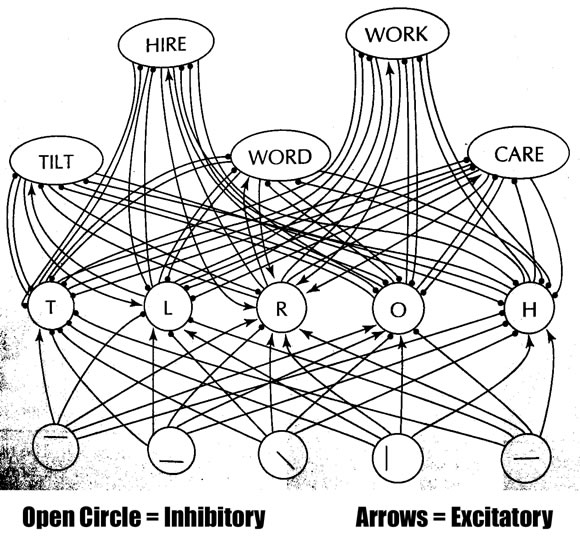Rocky slowly got up from the mat, planning his escape. He hesitated a moment and thought. Things were not going well. What bothered him most was being held, especially since the charge against him had been so weak. He considered his present situation. The lock that held him was strong but he thought he could break it. He knew, however, that his timing would have to be perfect. Rocky was aware that it was because of his early roughness that he had been penalized so severely – much too severely from his point of view. The situation was becoming frustrating; the pressure had been grinding on him for too long. He was being ridden unmercifully. Rocky was getting angry now. He felt he was ready to make his move. He knew that his success or failure would depend on what he did in the next few seconds.
[Frameworks for Comprehending Discourse -- Anderson, R.C., Reynolds, Schallert & Goetz]
What actually is going on in our minds as we read a passage like the one above? In theory this should be a relatively straightforward question to answer; nobody is as closely connected to our own minds as we are ourselves. Yet, it is precisely for this reason that this question becomes impossible to answer. Were our limited conscious capacity to be filled up trying to follow the uncountable, often competing, neural processes continually taking place throughout our brain, we would rapidly degenerate into entirely non-functional beings. Rather, our minds simultaneously analyze information from a myriad of different perspectives, weigh the relative strengths and weaknesses of each approach, then presents our conscious mind with only one single unified answer.
Take a look at the two faces below and see if you can match the emotions 'Calm' and 'Angry' to each (alternatively try 'male' and 'female')


(Click to enlarge and/or print)
(Dr. Angry and Mr. Smile: When Categorization Flexibly Modifies the Perception of Faces in Rapid Visual Presentations -- Schyns & Oliva)
For most people, even after completing this task, they remain completely unaware of the immense struggle their brain just went through -- unable to understand why ascribing an emotion to the above faces would have been any more difficult than any other faces. If you find yourself in this situation (don't worry everyone does), remember what answers you just gave to the left and right faces and try it again from far away (or if you have glasses, take them off).
Rather than alerting your conscious mind that its neurons for low spatial frequency and high spatial frequency vision were reporting different answers, your brain simply choose which one seemed the most likely answer and silenced the other one before reporting an answer to your conscious mind. Similarly, what happened when you read the passage about Rocky? While we still don't have a full account of how the brain works, we can clearly state what didn't happen. You didn't read each word, recall a definition of each word from memory, then combine the words + definitions together to create a meaning purely from the contents of the text (as would be the easiest process to design a language learning curriculum around if it were the case).
While much is still disputed about the inner workings of the brain, what is at this point all but universally agreed upon is that 'associations' are a key mechanism by which the brain operates. In reading the opening paragraph, your brain began a process of trying to associate the words it was looking at with all the various experiences you've had in your life until this point. Most likely, at some point a strong enough association was made between either your understanding of a prison or the sport of wrestling. At that point, your brain silenced alternate associations and focused on trying to make sense of how the passage you were reading could relate to your understanding of either prisons or wrestling.
Yet, even that describes only one of thousands of competing associative processes that were taking place at that moment. Consider what was happened in the pico-second while you were looking at the word 'Rocky'

(An Interactive Activation Model of Context Effects in Letter Perception -- McClelland & Rumelhart) in (Cognitive Psychology -- Medin, Ross, Markman)
Your primary visual cortex first registered that some parts of your screen
were darker than others. Further up in your occipital lobe, a group of
neurons were certain enough that the first arrangements of darkness
was a vertical line that they silenced other groups of neurons
checking if it was a horizontal line, circle or some other shape. As
other groups of neurons recognized a similar connected circle and diagonal line, various other groups of neurons that were working to check if that vertical-line/circle/diagonal-line pattern matched a
given letter of the alphabet. As the group of neurons associated with
the letter 'R' reached a strong enough threshold, they silenced all
the others. This triggered word-level groups of neurons to start
firing. As 'o' 'c' 'k' 'y' became strong enough, the word-level groups
of neurons for 'Rocky' became strong enough that they silenced
competing word neuron-groups. At this point, every association you had
ever made with the word 'Rocky' began firing. As other words from the
passage came in, some associations became stronger and others weaker. Eventually either a prison or wrestling schema became strong enough
that it silenced other associations and brought forth your experiences
with that schema.
As has been confirmed repeatedly by SLA researchers, while it may make for a convenient table of contents, linearly programming skills into students as incremental building blocks entirely fails to take into account the above mentioned processes. Today most curricular materials are organized around real-world themes ('asking for directions') rather than by linguistic building blocks ('wh- questions'). While this shift to real-world contexts has brought the typical foreign language classroom syllabus far more in-line with the associative nature of the brain, findings in cognitive psychology would suggest there are many avenues that could still be improved.
How does one decide the ordering of a foreign language syllabus? How much material should go into each chapter? How much of what should appear on each exam? The logical answer to these questions, it would seem, would simply be to try a few variations out in classrooms and see which ordering students respond to best. Who could argue with that?
Researchers following child first-language acquisition have long cautioned that the natural language development patterns for children universally involves learners getting worse at a particular grammatical pattern before ultimately getting better at it. More recently, work in cognitive psychology has also identified a number of common adult pedagogical practices which show strong short-term results, but fail to build rich long-term associations. Thus, if we design our curriculum based on immediate results, we are likely to miss the long-term implications of our choices -- many of which could be the complete opposite from their short-term results.
For example, much of our earlier fixation on PPP stressed the importance of first giving students a clearly organized Presentation outlining their expectations for the other two P's. Depending what we're measuring, however, this may not always be the best approach:
Mannes and Kintsch examined the effects of contextual interference on learning from the reading of text. Participants were given a certain period of time to study a technical, but somewhat interesting article on the industrial use of microbes and bacteria with the clever title, Industry in Ferment. Prior to studying this article, however, participants had either been given a consistent or an inconsistent outline to read. The consistent outline had the same structure as the article and 25% of the information in the article was presented in the outline; thus, it was very much like the type of advanced organizer frequently used in educational settings. The inconsistent outline had all the same factual information—thus it too had 25% overlap with the Industry in Ferment article—but it was actually the outline of an Encyclopedia Britannica article on microbes and, thus, it mismatched the article in a number of ways. After participants had studied their assigned outline and then the article, different types of tests were administered. When given a straightforward, verbatim recall kind of test, participants who had received the consistent outline performed better. When given a test that involved problem solving and a deeper understanding of the article, however, the participants who had received the inconsistent outline performed better.
[Research on Learning as a Foundation for Curricular Reform and Pedagogy -- Bjork]
Cognitive psychology experiments using a number of different tasks have consistently demonstrated over and over and over again (last link includes 40 examples) that interleaved presentation of content results in better long term retention than blocked presentation. That is, mixing different items from different tasks (one question about how to ask directions to a drug store, then one on purchasing toothpaste, then one on cleaning a cd-rom) results in deeper learning than learning one task at a time (repeatedly practicing and mastering asking directions). The effects of this are so extreme that even a completely chaotic and non-coherent interleaved ordering actually has better long-term results than a seemingly well organized design that structures material into logical blocks. Somewhat expectantly, though, students hate the chaotic approach.
The new wrinkle in the Simon and Bjork study was that participants were periodically stopped during training and asked to take a reading on how well they were learning the task. They were asked, if you were to stop training right now and come back in 24 hours, how well do you think you would do—that is, how close do you think you could come to the correct movement time. Participants in the blocked condition all predicted that they would do better than the participants in the interleaved condition predicted that they would do. In other words, their meta-cognitive assessment of how well they were going to do later was exactly wrong. Participants in the blocked condition most likely mistook the rapidity and apparent ease of their being able to perform the required movement patterns—made possible by the blocking of practice trials—as indicating that they were actually learning them well; whereas, the participants in the interleaved condition most likely mistook the slowness and apparent difficulty with which they were being able to perform the required motor pattern as indicating that they were not learning them well. (For a relevant discussion of such confusion between performance and learning in terms of the difference between the retrieval strength and storage strength of memories, as hypothesized in a new theory of disuse, see Bjork & Bjork, 1992.)
Thus, taken together, these two studies illustrate both how we, as instructors, can be misled if we only attend to or only have available to us the performance of our students during acquisition, and how we, as learners, can be misled into thinking that we are learning better under one condition than another when, in fact, the opposite is true. Unfortunately, as learners, we do not seem to be very good at assessing our actual state of competence or knowledge during training and seem easily misled concerning the conditions of training and instruction that are optimal. We seem, for example, to intuit that we are learning better under massed as opposed to spaced conditions of practice, or when the conditions of learning are kept constant as opposed to varied, or when we are given more rather than less feedback. Apparently, these conditions—because they support our performance during training—give us a sense of ease and a sense of learning that turns out to be misleading as far as the actual long-term learning that we are achieving. Whether or not, we, as learners, could be made to be more meta-cognitively sophisticated with respect to when we are or are not learning well is a topic of considerable research interest right now. (For a more thorough discussion of factors that can lead to such "illusions" of knowledge and/or competency, see Bjork, 1999, and Jacoby, Bjork, & Kelley, 1994).
[ibid]
The natural solution for language educators pushing a TBLT paradigm, then, is simply to ensure activities are designed around the larger meta-tasks ('fixing a scratched cd-rom') that they should be anyway and don't devolve back into repeatedly drilling micro-tasks ('asking directions') as is unfortunately still common in many U.S. introductory materials. In this way, content becomes naturally interleaved, but still retains enough coherence so as not to annoy students. From a production perspective, however, designing and producing meaningful meta-tasks is considerably more difficult than recycling the same micro-tasks. It is therefore important to recognize that most games are essentially already produced meta-meta-tasks that meaningfully (not to mention entertainingly) guide students through perfectly interleaved content.
For example, a character in The Sims 2 might get hungry, so you lead him to the kitchen to cook food. That leaves him tired, so you send him to the couch to watch tv. That leaves him feeling anti-social, so you have him phone his friends to come over. They want to go to the mall, so that leads you to call a cab to get there. That leads you to try choosing and purchasing clothing, etc.
![]() A possible map of how students might navigate a Neopets-like world modded for language learning
A possible map of how students might navigate a Neopets-like world modded for language learning
Research has shown that no matter how language is presented to learners, certain structures are acquired before others. This suggests that it is neither necessary nor desirable to restrict learners' exposure to certain linguistic structures which are perceived in linguistic terms to be 'simple' -- particularly when this involves the isolated presentation, ordering, and practice of 'simple' to 'complex' features.
Besides interleaving content, games help distribute the spacing of content -- another practice that has repeatedly shown minor short-term loss, but that leads to dramatic improvement in long-term retention. Often times a game will expose players to lots of content at the beginning, yet only require them to interact with an extremely limited set of actions. Only as players move to higher levels and become comfortable using new abilities does the game then entice them into taking advantage of their new abilities. (This, coincidentally, is the exact pattern prescribed by the Natural Approach)
This approach should be considered superior to simply repeating 'reviews' of earlier chapters, as it naturally (producers read: affordably) presents the same underlying task in a variety of different contexts and player/student mental states.*
When instruction occurs under conditions that are constant and predictable, learning appears to become what might be called contextualized. That is, while it looks very good in that context, the learning acquired in that context does not support retention later when tested in other contexts, and it does not transfer well to different contexts. In contrast, varying conditions of practice—even just the place where you study (as illustrated by Smith, Glenberg, & Bjork, 1978, and by Smith & Rothkopf, 1984)—can enhance recall at a later time.
[Research on Learning as a Foundation for Curricular Reform and Pedagogy -- Bjork]